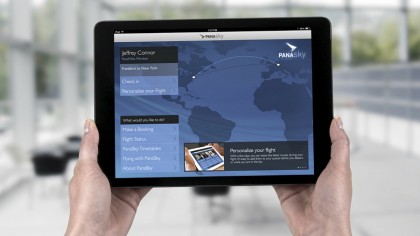The future of in-flight entertainment
In-flight entertainment is entering a turbulent time
The idea of armchair tourism has already been trialled by Quantas using its own app for Samsung Gear VR headsets for its First Class passengers.
Augmented reality could also take-off. Recently launched by Emirates in its economy cabin is an intriguing 'interactive amenity kit'. It's the usual bag of bits 'n' pieces – toothbrush, toothpaste, socks etc. – but this one can be scanned using the Blippar AR app to reveal activities and health tips. OK, so it's not Pokemon Go, but what did you expect at altitude?

New cabin designs
For those who've actually tried VR and know all about it's restricted field of view, the prospect of it at 40,000ft perhaps isn't that exciting. If you're after true immersion, why not just open the windows?
The Airbus Concept Cabin from a few years ago introduced the notion of transparent sides that could transform a night flight into a stargazing session, though vertigo suffers might complain.
Just as convincing from an IFE standpoint is the opposite; removing the windows altogether, which is what Trillenium promises.
"Windowless planes may sound grim, but they offer a wide range of entertainment options," says Niall McBain, CEO of global entertainment, publishing and media sales company Spafax, who suggests that outboard cameras, connectivity and servers have the potential to make any surface a projected image. "If you make the walls of the fuselage invisible to the naked eye, the experience of a windowless flight is likely to become the most immersive flying experience of all."
An end to seat-centricity
Another option is to move entertainment away from the seat altogether.
Get daily insight, inspiration and deals in your inbox
Sign up for breaking news, reviews, opinion, top tech deals, and more.
"The opportunities for entertainment spread beyond the individual passenger's seat," says Hugo Jamson, Associate Director at airline innovation and design studio New Territory, who adds that expecting passenger seats to give adequate comfort, sleep, dining and entertainment is unrealistic.
"Rather than accepting the flight experience as one that is uniform throughout the cabin, delivered through a uniform seat/entertainment platform, we want to be treated to more unique and flexible experiences," says Jamson. "This suggests entirely new spaces on board, new types of digital and analogue experiences, new ways of being alone or socialising."
From dining to working, from culture to gaming, new spaces will break down the 'seat-centricity' of the flight experience. However, creative thinking like this will come at a price, with access to these spaces offered as part of a web of upgrades.

Ubiquitous in-flight Wi-Fi and connected cabins
Almost 13,000 commercial aircraft are forecast to offer in-flight connectivity to passengers by 2023. Though satellite-powered internet access for planes – and Wi-Fi connectivity in the cabin – certainly isn't everywhere, it is spreading.
Emirates reports that over a quarter of all passengers use the internet during their flights, which increases to half on flights over 12 hours.
"The economics of in-flight Wi-Fi services now make sense. Guests can experience internet speeds similar to what they have at home, and there's a large movement toward personalisation," says Don Buchman, vice president and general manager, Commercial Mobility of satellite communications companyViaSat, one of the major providers of inflight internet.
In-flight Wi-Fi will completely transform the passenger experience.
Buchman believes that the cabin crew will soon be able to know the preferences of every passenger, perhaps delivering a snack at a specific time via an app.
"In-flight Wi-Fi will completely transform the passenger experience, allowing passengers to order duty free and arrange for items to be delivered straight their homes, make last-minute Uber collections, read TripAdvisor articles, and even connect with other tourists travelling to the same destination," he says.

Wi-Fi faster than the speed of sound
In theory, access to Wi-Fi could supersede the need to access a carrier's in-flight entertainment.
But there's a problem.
"In-flight connections are often slow, unreliable and expensively priced," says Curran. "Carriers still rely on a network of 3G ground stations, which communicate with the plane as it passes over."
In fact, the total bandwidth for an entire plane can be less than 4MB. You want Netflix or live TV? Forget it. Both are only possible if the plane is fitted with satellite internet access, instantly jumping to 50Mbps.
In the future, it is expected that more airlines will move to using Ka-band (26.5-40GHz) satellites, which provide up to 100 times the capacity of regular Ku-band.
"In the future, it is expected that more airlines will move to using Ka-band (26.5-40GHz) satellites, which provide up to 100 times the capacity of regular Ku-band," says Curran.
Cue cloud-based inflight entertainment systems like Aircell's GoGo Cloud, UltraViolet and Arconics' CloudStore, which can deliver Netflix and live TV streaming. Netflix is something already offered by some airlines, including Aeromexico and Virgin America.
Sports at 40,000ft
There's nothing worse than realising you've booked a flight that clashes with a big game. That's why there's Sport 24 and Sport 24 Extra, two live sports TV channels available through Panasonic's eXTV television network.
This multi-timezone, multi-sports channel is a tie-up with IMG, and Barclays Premier League, Bundesliga, UEFA Champions League, Formula 1, NBA, NFL, Ryder Cup, golf majors and tennis grand slams.
They're available on 13 airlines including Emirates (any B777 flight with Wi-Fi – and, therefore, global satellite coverage), whoseice TV Live also includes myriad live news channels. The two channels will also provide live coverage of the Rio 2016 Olympics this August.
Now, if only airlines could crack the big one: standardising in-seat USB slots for refuelling phones and tablets.
- 1
- 2
Current page: Ubiquitous Wi-Fi and connected cabins
Prev Page The future of in-flight entertainmentJamie is a freelance tech, travel and space journalist based in the UK. He’s been writing regularly for Techradar since it was launched in 2008 and also writes regularly for Forbes, The Telegraph, the South China Morning Post, Sky & Telescope and the Sky At Night magazine as well as other Future titles T3, Digital Camera World, All About Space and Space.com. He also edits two of his own websites, TravGear.com and WhenIsTheNextEclipse.com that reflect his obsession with travel gear and solar eclipse travel. He is the author of A Stargazing Program For Beginners (Springer, 2015),
